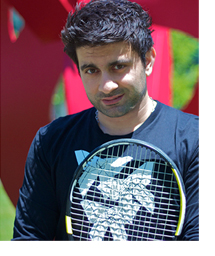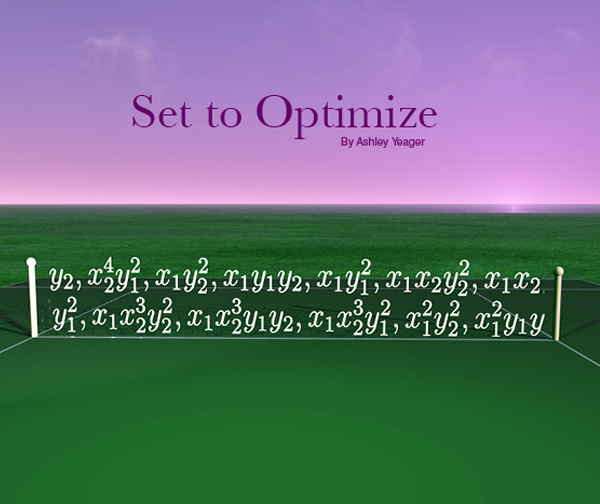Amir Ali Ahmadi's dream throughout childhood was to become a professional, world-class tennis player. Growing up in Tehran, he first picked up a racket at age seven, playing in a summer camp run by the man who was then the head coach of the country's national team. By 11, Amir Ali was playing competitively, and at 17, he played for the Iranian National Junior Team. Yet, he was always the top student at school.
"I pretty much gave up on professional tennis when I moved to the U.S. when I was 18. I gave it a little try at the beginning, won a couple of little tournaments here and attended the Bollettieri Tennis Academy in Florida for a short period," he says. "But soon I realized that my chances were very low for going pro, so I switched my focus to school."
Despite his early love of tennis, Amir Ali had also developed an interest in math and science at a young age. He started to focus on these interests during his college years at the University of Maryland. A defining moment for him, he recalls, was in a computer programming class during his freshman year. His professor gave the class an assignment to implement an ingenious algorithm, which could multiply two two-by-two matrices with only seven multiplications instead of the usual eight. Amir Ali wasn't really interested in the programming assignment but in the algorithm. "In the years prior to this class, I had multiplied hundreds of matrices, and it bothered me that I never once asked whether there was a way to do it with fewer multiplications," he says. Discovery that a faster way was possible made Amir Ali think about how he approached other mathematical problems.
After taking another class on signals and systems theory, he says he was convinced he wanted to work on the mathematics of electrical engineering and computer science. In 2006, he graduated first in his class in both of his majors – mathematics and electrical engineering. Preparing to continue his studies, he had applied to several graduate schools and choosing where he would attend was tough at first. But when Amir Ali met LIDS professor Pablo Parrilo on a recruiting visit to MIT, he says he "knew right away" that he wanted to work with him.
"Pablo is passionate and energetic about his work. He is super smart, and after just one meeting I knew he'd be a great advisor," Amir Ali says.
He accepted a research assistantship from Pablo and together, the pair began to look at some algorithmic problems in systems and optimization theory. "There's lots of optimization in the real world. It's everywhere," Amir Ali says. A NASA scientist, for example, might want to move a group of satellites into a specific configuration to carry out a mission while making sure that they don't crash on the way there. But to make those movements costs fuel and, depending on the route chosen, time. "Whatever you do, you have to do it with some cost," Amir Ali says, offering another example of having doctors on call in the emergency room. If there are too many doctors and not many emergencies, then the doctors are paid without doing work. The cost is too high, and money is wasted. But if there are too few doctors, there's a long wait for patients and the cost is time. "Optimization is about balancing these trade-offs in the most efficient and effective way possible," Amir Ali says.
He adds that in these examples, scientists can plug the scenarios into a computer and calculate the optimal path of the satellites or number of doctors. Amir Ali, however, looks at problems like these in their pure mathematical form. He doesn't deal directly with specific scenarios, but instead wants to develop tools that scientists can use to optimize a wide range of systems arising in different domains.
Unfortunately, not all optimization problems are so easy to solve, and, in some cases, there is no efficient algorithm to provide the optimal solution. This is where Amir Ali's work comes into play. He studies what makes some optimization problems easy to solve and what can be done to deal with the problems that are provably hard to solve.
Problems described by convex functions form an important class of optimization problems that scientists know how to solve efficiently. Like a convex lens, the graph of a convex function swoops downward from both sides, forming the shape of a bowl or the bottom of an unbroken egg. When a function takes this shape, finding the overall minimum value is easy and quickly gives scientists the optimal solution to their problem.
Functions that are not convex, however, can have values that only appear to be the overall lowest point, but instead are really local minimum values on a wavy graph that looks more like artful origami than the bottom of a bowl. A question that Amir Ali recently worked on was to see if there is a systematic and efficient way to determine if complicated functions are convex or not. In 1992, this question became one of seven outstanding challenges to be solved in the field of optimization. It took until 2011, but Amir Ali and Pablo, together with LIDS professor John Tsitsiklis and his former student Alex Olshevsky, finally answered the question. The answer was no. Determining convexity of complex functions is so hard that it can quickly go beyond the capability of even the world's most powerful computers.
Not deterred by this answer, Amir Ali showed that in many cases scientists could use a property that can be checked efficiently, known as sum-of-squares convexity, as a viable substitute for convexity. The algorithm for checking sum-of-squares convexity borrows ideas from classical algebra. "This is a very exciting area of optimization theory, for one thing because it has its roots in some beautiful and classical work in algebraic geometry done in the late nineteenth and early twentieth centuries," Amir Ali says. He explains that around the year 2000, Pablo and a few others drew a connection between classical algebra and some modern tools in optimization theory. "This gave an algorithmic twist to many algebraic problems and opened up a whole new area of research and a wide array of potential applications," Amir Ali says. He and Pablo have developed the analogue of some of the classical results in this area for their problem of checking convexity. Their result also highlights the relationship between convexity and sum-of-squares convexity.
Like many other students and faculty at LIDS, Amir Ali is also interested in systems and control theory. His work in this area is focused on the design of algorithms -- based on optimization theory -- that can provide guarantees about how dynamical systems behave. These algorithms can predict, for instance, if a certain epidemic disease will die out, or if particular types of trading and investment strategies among financial institutions can lead to financial instability. For the algorithms to be useful, they should be able to predict the qualitative behavior of the system even if some parameters – the transmission rate of the disease, for example – are not precisely known, Amir Ali says. In this area of research, he has designed new algorithms and studied the limitations of particular sets of algorithms that use convex optimization, algebraic methods or other mathematical tools.
Amir Ali will be continuing this work at Purdue University as an Assistant Professor of Quantitative Methods in the School of Management after first spending a year on leave to do research at the IBM Thomas J. Watson Research Center as the 2012-2013 Herman Goldstine Memorial Postdoctoral Fellow. As for tennis, Amir Ali still hasn't quite given up his childhood dream. IBM Research has a group that is the world-leader in tennis analytics and statistics, and Amir Ali is hoping he can work with some of the major players there on the project. He also still dreams about playing for the Iranian Davis Cup Team, which, he says, "is a more achievable dream."




